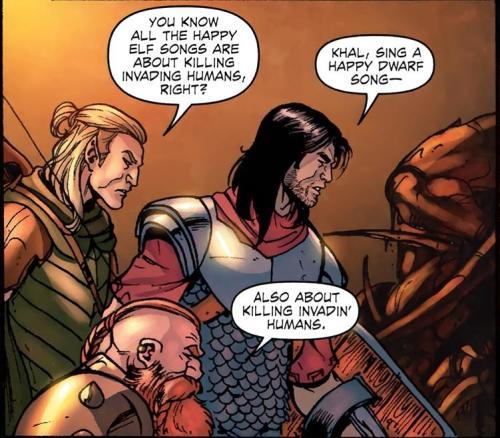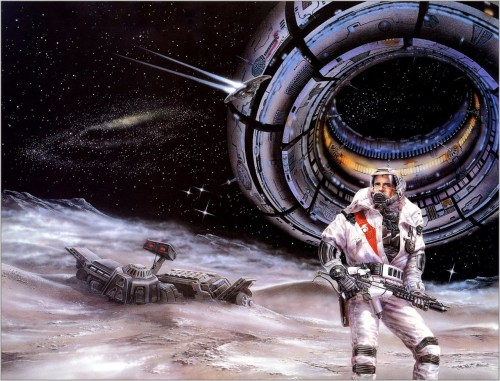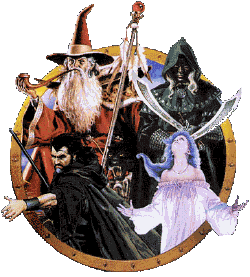Spacer Campaigns: The Jovian Expanses and Outliers
There are as many mysteries in space as there are on Earth. Here are a few:
The Jovian Expanses
This is a collection of loosely organized Free Colonies with a strong neo-libertarian bent. The region is dominated by three primary colonies, being Europa, Ganymede and Saturn’s Titan, while dozens of smaller colonies and hundreds of mining and development facilities can be found throughout the greater region. The need for cooperation and resource management has insured that the otherwise loosely allied colonies of the Jovian Expanses remain cooperative and not hostile; the only real “police force” in the region recognized by all the Expanses as a proper authority is that of the Europan-based Expanse Investigations Offices. The EIO serves primarily to address issues of piracy and sabotage among the many independent corporate agencies and private parties of the predominantly libertarian domain of the Expanses, and works on a per-contract basis; for a colony to gain the advantage of the EIO it must be willing to pay the necessary insurance to provide funding and support for the organization. In turn, the government of Europa out of Galileo City provide supplemental dollar-matching funding, in exchange for more favorable contracts with the outliers and free colonies. So far, this has worked, much to the detriment of the inner-system socialist Solar Collective.
Europa
The principle governing colony world in this region is Jupiter’s moon Europa, where the vast ice-floating city of Galileo can be found. Galileo was founded early on in the advancement to space, and it became a center of outer-system exploration due to its unique position, providing water resources from Europa’s buried ocean while also providing extensive research on the nature of its vast oceans.
Europa was discovered early on to hold ocean’s full of microbiotic life, but no advanced lifeforms had evolved there at the time of discovery. In the century and a half since, rapid advances in bioengineering led to the development of engineered lifeforms specifically designed to populate the waters of Europa and to serve as a specialized developmental ecosystem, as well as a food source. The runaway success of this project has led to Europa being the third most “terraformed” body in the solar system, after Mars and Europa. The rapidly developing aquatic ecosystem is contributing greatly toward a more oxygen-saturated planetary atmosphere, although the likelihood that the moon will ever hold onto a thicker shell of atmosphere remains improbable. At present, humans can only venture onto the surface of the moon in suits; lethal radiation due to lack of atmospheric shielding otherwise prevents the moon’s surface from being hospitable.
The bulk of the “floating city” is beneath the ice. The vast construct and its outliers were part of a massive works project that began well before the death of Old Earth and continued to this day. The first fully sentient and self-aware quantum AI, calling itself Simon Marius, serves as the functional administrator and arbiter of the city, providing a relatively safe environment and responsive body of governance that the Europans have come to accept. Unlike most futuristic “AI doom” predictions, Marius continued to function in a manner that was mutually beneficial to himself and his creators.
Ganymede
The second most important colony world in the Jovian Expanse, Ganymede provides much-needed mined water resources as well as silicate and other resources. Much of the human-inhabited region is underground in the somewhat more stable planetary geology, to take advantage of natural rock as a shelter from the extensive radiation in the region. Ganymede has become a center of activity for starship construction and development, a feature that predates the collapse of Old Earth, and it has several orbital shipyards that provide new and much improved designs for outer-system starships; it actually makes a fair amount of money selling hulls to the inner colonies of the Solar Collective, as well. This prosperity and independence has made Ganymede the center of trade and commerce in the region for industrial construction and manufacturing, while its sister colony Europa provides food and water resources.
Ganymede’s center of trade and commerce is the orbital station Commerce. Ground-side, its dominant industrial city is Tether, which is not coincidentally linked to Commerce by a Space Elevator, the largest and most effective of its kind; only the old Space Lifts of Earth were regarded as more impressive, and virtually all of those have long since decayed and collapsed, catastrophically.
Other Moons of Jupiter
Not all Jovian moons are suited to colonization, and some are only approached by local mobile fleets for brief resource mining operations. Still others have developed extensive habitats about them, and are now part of the regular trade lanes of activity. A quick summary follows:
Amalthea (Inner) Satellites: the inner satellites closest to Jupiter are dangerous and only independent miners (commonly called belters) tend to be crazy enough to look for precious metals and other resources on Metis, Adrastea, Amalthea and Thebe.
Plot Point: There is a story that there’s a permanent colony on Amalthea, the ellipsoid inner moon that skirts the edge of the Jovian rings. This otherwise hostile moon is said to have contained a secret, an ancient monument of extraterrestrial origin, according to the self-proclaimed space prophet (and madman) Johnias Whinn. Thirty years ago he, a former eccentric billionaire, left his position as CEO of the SysStar Corporation and poured his resources into an investigation of the moon after strange stories surfaced from local belters who claimed they had found extraterrestrial artifacts. Although no independent observation has corroborated this, Whinn nonetheless claimed to have found something, and built a terradome on the planet’s surface, protected by an orbital defense platform manned by an AI called Searcher. Contact with the colony was lost ten years ago when a major impact presumably disabled or destroyed it and its orbital watchdog platform, but no one really knows. Remnants of his group, called the Searchers, still exist in odd pockets, including on Saturn’s Iapetus, where they seek evidence that the entire moon is actually a constructed vessel.
The Main Group: This group of moons includes Ganymede and Europa, as well as Callisto and Io. Io is an aggressively difficult moon to colonize, and most of the activities that go on are temporary operations staged from orbital platforms. Callisto, in contrast, suffers less from Jupiter’s magnetosphere and lacks any interior volcanism; dozens of small interdependent colonies exist on its surface and work in tandem to provide resources to one another. The local mining is mostly at the surface level, and three primary orbital platforms serve as the tether to the rest of the universe and the local colonies. Most of the colonies are a mix of subterranean and surface development, with the surface shielding less aggressive than at other inner system and main group colonies.
Plot Point: There’s currently something of a revolution going on in the many interdependent colonies of Callisto, where generations of regional interaction have led to several movements to develop a unified local government. Currently there are dozens of political parties lobbying for votes in the first round of elections, and the most outstanding party leader is one Clarence Durnham, leader of the Independence Party, which is strongly anti-outsider and also anti-AI. This has led to concern from neighbors Europa and Ganymede, who feel that such an isolationist party could be costly to the rest of the Expanse.
The Irregular Satellites: With so many irregular minor satellites in eccentric outer system orbits, its hard to even begin to keep track of the many colonies, private interests and other mysterious agencies out there, struggling to survive or otherwise looking for easily mined resources. As often as one finds an active colony or mining op you will just as likely stumble across an abandoned or defunct ruin. It’s a wilderness of survival.
Saturnian Space and Titan
Saturn is the edge of the outliers, the vast and untamed region of outer system activity that does not recognize the authority of any inner system powers, and engages in trade only with certain Jovian Expanse members. The only local authority of note is in the Diaspora of Titan, centered on the mining city of Herschel, which is managed by a benevolent AI called Devon. The Titan colonists are fiercely independent, and corporate and private influences are dominant in the Saturnian system, with absolutely no central authority or body of law outside of the all-mighty contractual agreement. What few disputes arise are often resolved in the free courts of Herschel, a loose civil protection system that moderates contractual obligations and rights. This movement toward total Capitolist Free Enterprise and the envelopment of personal and commercial rights into contractual obligations began during the dark years immediately following the destruction of Old Earth; in this period, the risk of death by asphyxiation due to lack of replenishable resources for air, water, food and other resources (never mind fuel) led to a rise in regional influence by corporate structures that quickly moved in to fill the void that was left with the destruction of Earth’s governance. It has steamrolled since then, and has rapidly become a cut-throat way of life in the region that even the quasi-unified libertarian colonies of Jupiter find disturbing in the way humans are regarded as commodities.
Enceladus
Aside from Titan, Saturn’s second most populous moon is Enceladus, where active regular mining groups produce much needed water and other resources for the region. This is also the moon with the largest concentration of shipyards. It is dominated by Cronos, the megacorporation that first founded the initial mining colonies and was given main privileges during the Old Earth years to administer local government. Cronos was a major factor in the contract-based rule of governance in the Saturnian region.
Iapetus
Iapetus is another moon on which numerous colonies can be found, including its largest which is Engelier City, built in the Engelier crater. There is a regional mystery, clouded by the efforts of local corporate powers, suggesting that evidence of extraterrestrial architecture related to Iapetus’ 1,300 km long equatorial ridge have surfaced. To date no one takes such claims seriously as groups like the Searchers appear to be fanatical and easily misled into believing natural formations are actually artificial, but some researchers feel there is evidence of writing found in petroglyphs along the ancient and mysterious ridge, and a few dedicated scholars (including Hans Orman of the Solar Collective) have made the study of this moon their life’s work, spending years at a time in the rough outlying colonies searching for clues, be they geologic or extraterrestrial as to the origin of Iapetus’s mysterious Equatorial Ridge and so-called writing.




















